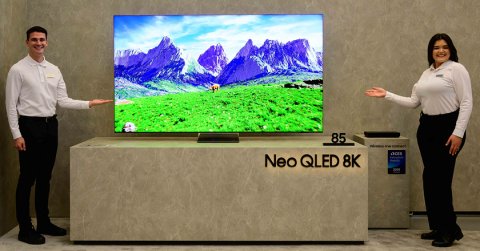In an exclusive interview, CNME Editor Mark Forker spoke with Rohit Khubchandani, the newly appointed Regional Sales Director for Oosto in the Middle East, in an effort to find out how the global Vision AI solutions leader is making waves with advanced solutions that enhance safety and security across various industries.

In this discussion, Rohit also dives into the intricacies of Vision AI, Oosto’s approach to cloud technology, and the company’s global deployments in high-profile locations such as airports, casinos, critical infrastructure, and sports/hospitality venues.
Rohit, good luck in your new role at Oosto! For those new to the company, could you explain what Oosto specializes in and how it is driving the future of AI-powered security solutions?
Oosto specializes in Vision AI, with a focus on real-time face, body, and behavior video analytics.
Our core mission is to enhance safety and operational efficiency by providing solutions that allow businesses to potentially prevent security incidents and proactively manage security threats in real-time.
What makes Oosto stand out is our commitment to ethical AI, ensuring that we deploy technology in a way that protects privacy while delivering unparalleled accuracy. Whether it’s preventing security breaches in airports, managing large crowds at sports venues, or providing seamless access control in commercial environments, Oosto is redefining how AI-driven technology can be leveraged for safety, security, and peace of mind.
Vision AI is a key part of Oosto’s technology. Could you describe how it works, and why it’s so effective for real-time facial recognition?
Vision AI, at its core, uses advanced machine learning algorithms to analyze video feeds in real time. Our neural networks deployed on our clients’ existing CCTV cameras, can quickly and accurately alert persons of interest by comparing live images to extensive watchlists.
What makes our Vision AI so effective is its ability to process large amounts of visual data instantaneously, providing actionable insights on not just face matches for watchlist alerting, but also on actions over a period of time such as a person loitering or unauthorized entry into a defined area.
In addition, Oosto combines facial recognition detections with skeletal body models to track a person of interest in real time – even when a face is not included in every camera detection.
The technology is designed to function seamlessly even in complex environments like airports or casinos, where lighting conditions, crowd density, and movement can pose challenges. Vision AI’s speed and precision make it a critical tool in enhancing security without disrupting day-to-day operations.
Oosto’s technology is used globally in various industries. Could you share some examples of where your solutions have been deployed?
We’ve seen Oosto’s technology successfully deployed across a variety of industries worldwide. In Las Vegas, for example, over ninety percent of the casinos on the Las Vegas strip use our person of interest alerting powered by live facial recognition to enhance security, identifying persons of interest in real time and helping protect both guests and staff.
Our solutions are also being used in sports venues and stadiums, where managing large crowds and preventing potential incidents is crucial. Airports are another key sector—our systems are deployed in several international airports to enhance border security and streamline passenger movement. The versatility of our Vision AI solutions means they can be applied to any high-security environment that demands real-time, accurate threat detection.
Oosto has introduced a hybrid approach when it comes to its cloud offerings. Could you elaborate on this and how it benefits your customers?
Absolutely. Oosto was one of the first companies to offer real-time facial recognition, plus pose and action detection via edge-to-cloud deployment. Our cloud solutions also include behavior recognition, which allows organizations to not only track faces but also detect specific actions or patterns that might indicate a security concern.
The key advantage of our hybrid approach is rapid deployment across multiple locations and cost-effective scale. By processing much of the data at the edge—on local devices—we reduce the heavy lifting typically done by the cloud. This minimizes the amount of video data that needs to be transferred and stored in the cloud, cutting down on bandwidth and cloud storage costs.
This approach delivers a higher ROI for our customers, especially in large deployments where continuous cloud processing can be prohibitively expensive. It’s a flexible model that ensures efficiency without compromising performance or accuracy.
How does behavior recognition work within Oosto’s cloud offerings, and what types of scenarios is it designed to address?
Behavior recognition is a powerful feature of our solutions. Essentially, it enables security teams to define custom rules that match specific people with actions over a given time frame, giving them a complete picture of what’s happening in real-time. For instance, if an unauthorized person crosses into a restricted area and remains in that area for longer than 20 or if an unusual activity, such as a slip and fall, occurs in a facility, our system can automatically generate an alert.
This capability is highly beneficial in environments where monitoring human behavior is just as important as identifying individuals. The integration of facial and behavioral analytics ensures that security teams can act quickly, whether it’s responding to a safety incident or preventing a security breach.
One of the challenges with cloud-based facial recognition technology is the cost of data storage and bandwidth. How does Oosto address this?
Managing cloud costs is a significant concern for many organizations, especially with the vast amounts of data generated by facial recognition systems. At Oosto, we address this by taking a hybrid approach.
By processing data locally on edge devices, we minimize the need to send large volumes of video data to the cloud, reducing bandwidth and storage costs significantly.
This approach not only improves cost-efficiency but also speeds up processing times, as real-time analysis can be performed without relying on constant cloud connectivity. The result is a more cost-effective solution that still delivers the high accuracy and performance needed for critical security applications.
Real-time facial recognition systems like Oosto’s need to handle significant volumes of data. How does your technology maintain high accuracy under these conditions?
Maintaining high accuracy is essential, particularly in large-scale deployments like airports or sports venues. Oosto’s Vision AI technology is designed to process data rapidly and accurately, ensuring that it can identify individuals even in challenging conditions like low-light environments or crowded spaces.
Our systems are optimized to handle large watchlists and multiple camera feeds simultaneously, ensuring that no potential threat goes unnoticed. By continuously improving our machine learning models and using sophisticated algorithms, we ensure that our systems remain both reliable and scalable, regardless of the deployment size.
With facial recognition technology often drawing privacy concerns, how does Oosto ensure its systems are ethically implemented?
Privacy is one of our top priorities, and we’re deeply committed to what we call Vision AI for Good, the idea that our focus is on mission critical use cases and our technology should ONLY be deployed and used in ways that align with the highest ethical standards. Oosto’s systems are designed to balance security with privacy, ensuring that only relevant data is captured and used.
For watchlist alerting use cases, we do NOT provide any watchlist data – customers start with an empty database that they and they alone populate. Our facial recognition technology focuses solely on identifying persons of interest, and we ensure that personal data is encrypted and protected according to global standards, including GDPR. Additionally, we work closely with our customers to ensure that their use of our technology complies with local regulations and ethical guidelines. Transparency and accountability are at the core of how we implement our AI solutions.
Oosto’s solutions are integrated with video management systems (VMS) like Milestone Systems and Genetec. How does this enhance the overall security infrastructure for your customers?
Importantly, we are VMS and CCTV camera agnostic. We can work with any IP camera. As well, integrating our facial recognition technology with leading VMS platforms like Milestone Systems and Genetec is key to providing a seamless security solution for our customers. These integrations allow security teams to manage and monitor their entire system from a single platform.
It simplifies the process of identifying potential threats and responding to incidents quickly. By combining the capabilities of Vision AI with existing security infrastructure, we enhance the overall operational efficiency and ensure that organizations get the most out of their surveillance systems.
Finally, as the Middle East continues to invest in smart cities and advanced infrastructure, how do you see Oosto playing a role in these developments?
The Middle East is a forward-looking region when it comes to adopting cutting-edge technology, and Vision AI will play a crucial role in the development of smart cities. With increasing demand for secure and seamless environments in sectors like transportation, retail, and public spaces, Oosto’s technology is well-positioned to meet these needs.
Our solutions can enhance both security and efficiency in smart city environments, helping governments and organizations ensure safety while improving the overall quality of life for citizens. I’m excited about the future and Oosto’s role in shaping these advancements in the region.





